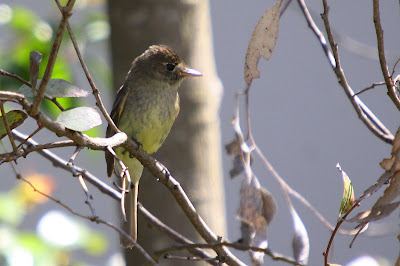There was not a cloud in the sky for about an hour this morning, then the gloom descended again. Everything is green, however and bursting into flower. Brown and White-cheeked Honeyeaters, Silvereyes, Yellow Thornbills, Red-browed Finches, Grey Fantails, and Willie Wagtails, were among our walking companions.
Friday, July 30, 2010
Sunday, July 25, 2010
Stockton Sand Spit


Two Pacific Golden Plovers have remained at the Stockton Sand-spit for the winter. Usually the birds arrive in September and head off for the Alaskan Breeding Grounds in April. The bird in dark breeding colours had an injured leg, and the other appeared to be a juvenile.
In Australia Pacific Golden Plovers usually occur on beaches, mudflats and sandflats in sheltered areas including harbours, estuaries and lagoons. Important sites for the species within Australia are Broome, Moreton Bay, Shallow Inlet Marine Park, the Coroong, and the Hunter River Estuary.
They have one of the longest migration routes of any bird, along the East Asia-Australasian Flyway, and much of it is over open ocean with no opportunity for food or rest. It no longer seems surprising that these two stayed put.

BTW The collective noun for a group of plovers is a ‘deceit’.
Friday, July 23, 2010
Myuna Bay
Scaly-breasted Lorikeet
Rainbow Lorikeet
Musk Lorikeet
Eastern Rosella
Flowering trees brought out the nectar and pollen feeders, and the banksias and eucalypts were filled with colour and noise.
Lorikeets are brightly coloured parrots of the family. Six species are found in Australia. They travel in small, swift flocks which attract attention with their piercing calls. The birds locate the blossom by sight and by the calls of other birds already feeding. When food is abundant, large numbers gather in the blossoms and foliage, clamouring noisily.
They are attracted to home feeders however well meant treats based on sugar, honey or jam are leading to the birds’ early deaths from necrotizing enteritis, a disease associated with an inadequate diet, and psittacine beak and feather disease (PBFD) which is spread through poor hygiene at feeders.
The only feeding method recommended by the National Parks and Wildlife Service is to plant a variety of flowering native shrubs, such as grevilleas, callistemon (bottlebrushes) and banksias, in the garden.
Wednesday, July 21, 2010
Hi Fert
Bar-shouldered Dove
White-browed Scrub Wren
Back on our home turf at HiFert on Kooragang Island, the dogs happily followed scent trails on the grass while the scrub wrens scolded from the bitou bush. The resident group of bar-shouldered doves had found spilled grain by the side of the road, and a group of around thirty red-browed firetails satisfied themselves with grass seeds.
The male superb-fairy wrens were resplendent in their breeding plumage. Willie-wagtails and grey fantails were hawking for insects, and yellow thornbills and silvereyes hid in the casuarinas. Brown honeyeaters and a single red wattlebird called from the banksias.
A young white-bellied sea eagle cruised overhead, little inconvenienced by the screeches of the masked-lapwing. White and straw-necked ibis pecked over the boggy areas.
Over the river were great crested terns, silver gulls and Australian pelicans while little pied and little black cormorants floated on the surface.
Tuesday, July 20, 2010
Tighes Hill
I was working at home today when a flock of around eighty little corellas flew in with their characteristic clamour. They took turns ripping flowers from the big paperbark on the bank of the creek and then left as suddenly as they arrived.
Monday, July 19, 2010
San Joaquin Marsh
June was a rather miserable month to be birding in Orange County, birds were few and far between and the constant fog/smog/gloom took the pleasure out of being outdoors and complicated photography. Still my primary purpose for being there was work, and the second was to catch up with family, so perfect birding conditions would have caused a severe conflict of interest.
The last couple of days before I returned home things started to improve with the gloom lifting earlier in the day, and signs that shorebirds were starting to return south. The first arrivals were adult birds in breeding plumage. Small groups of sandpipers, godwits, whimbrels and plovers were foraging on the mudflats, nervously establishing their rights to a patch.
Wednesday, July 14, 2010
San Joaquin Wildlife Sanctuary
Friday, July 9, 2010
Orange County
At the time I was editing photos from my excursion to the Tucker Wildlife Sanctuary.
Wednesday, July 7, 2010
Tucker Wildlife Sanctuary
Sunday, July 4, 2010
William R. Mason Regional Park
Broad paved paths made walking easy, but the dense shrubs on either side helped the birds stay out of view, and I heard a number of birds I couldn't identify. But there were a group of Lesser Goldfinch eating thistle seeds, several Pacific Slope Flycatchers hawking from a vine covered tree, and Common Yellowthroat feeding young in the reeds.
Thursday, July 1, 2010
San Joaquin Wildlife Sanctuary
Bird List:
Pied-billed Grebe
American White Pelican
Double-crested Cormorant
Great Blue Heron
Great Egret
Green Heron
Turkey Vulture
Mallard
Green-winged Teal
Ruddy Duck
Osprey
California Quail
Common Moorhen
Killdeer
Black-necked Stilt
American Avocet
Caspian Tern
Least Tern
Black Skimmer
Morning Dove
White-throated Swift
Anna’s Hummingbird
Allen’s Hummingbird
Black Phoebe
Western Kingbird
Warbling Vireo
American Crow
Common Raven
House Wren
Northern Mockingbird
European Starling
Spotted Towhee
California Towhee
Song Sparrow
Red-winged Blackbird
Brown-headed Cowbird
House Finch
Lesser Goldfinch

























